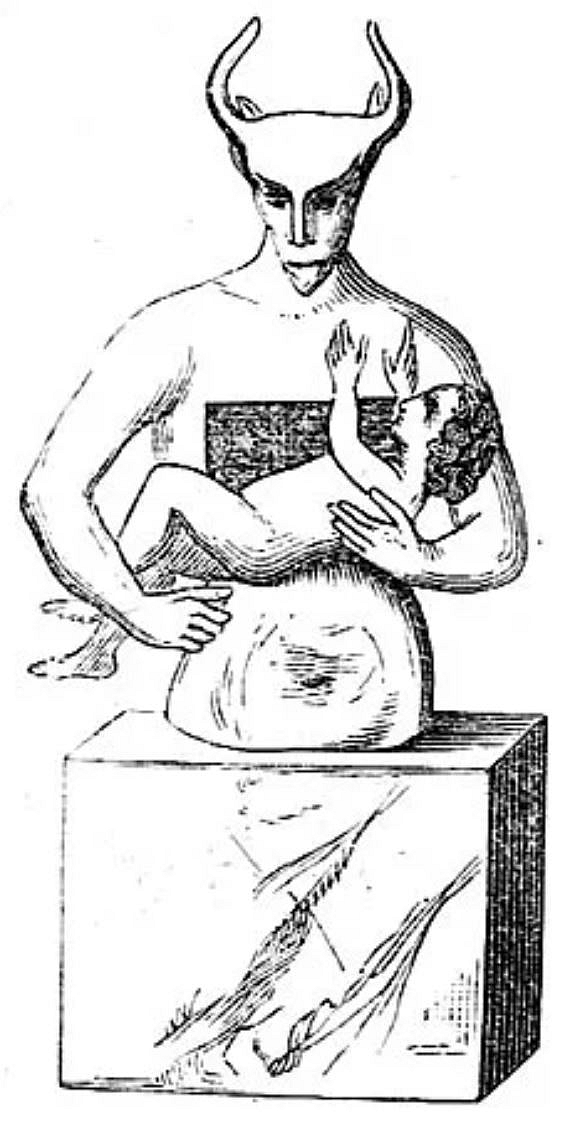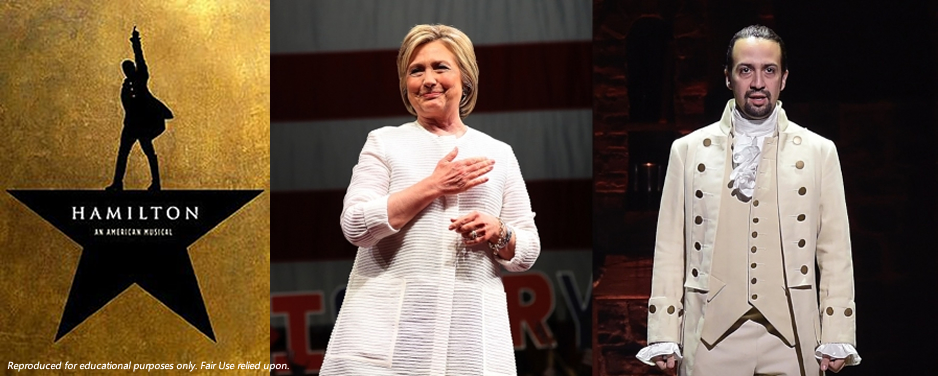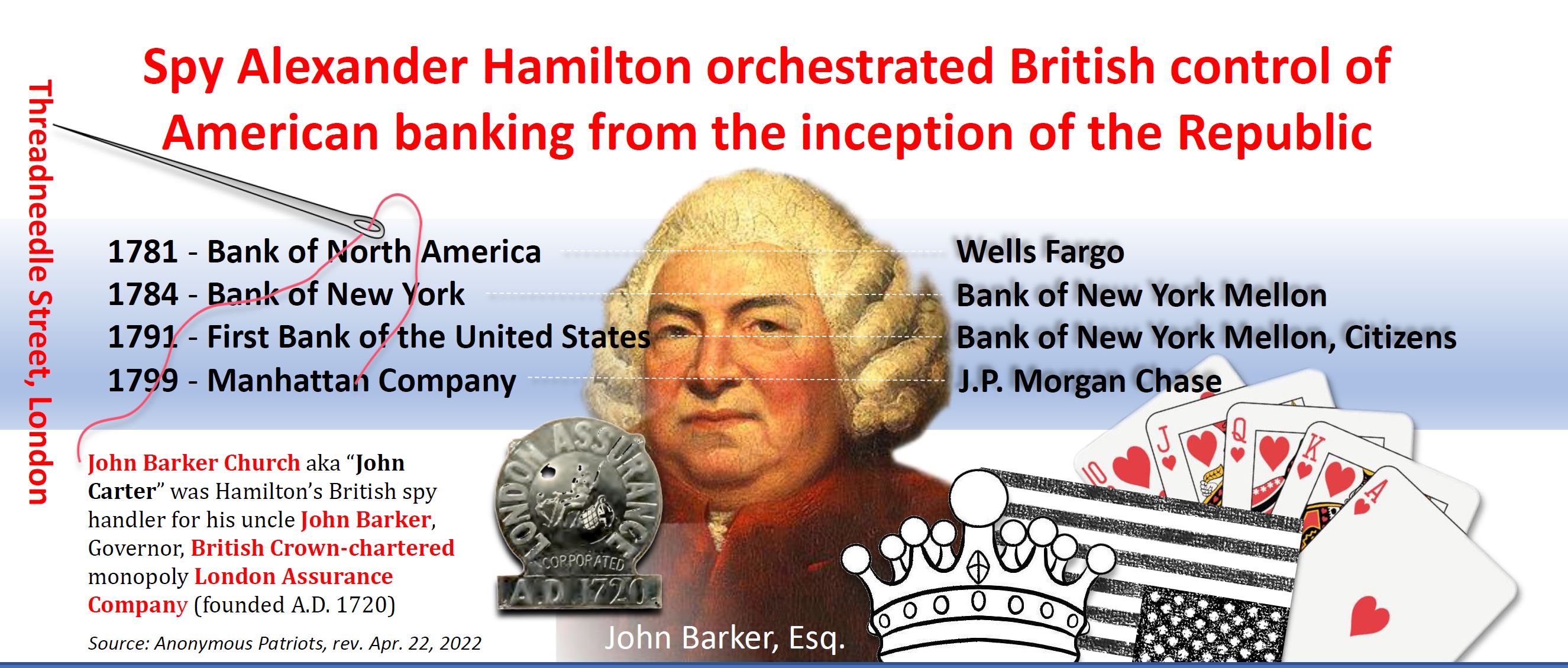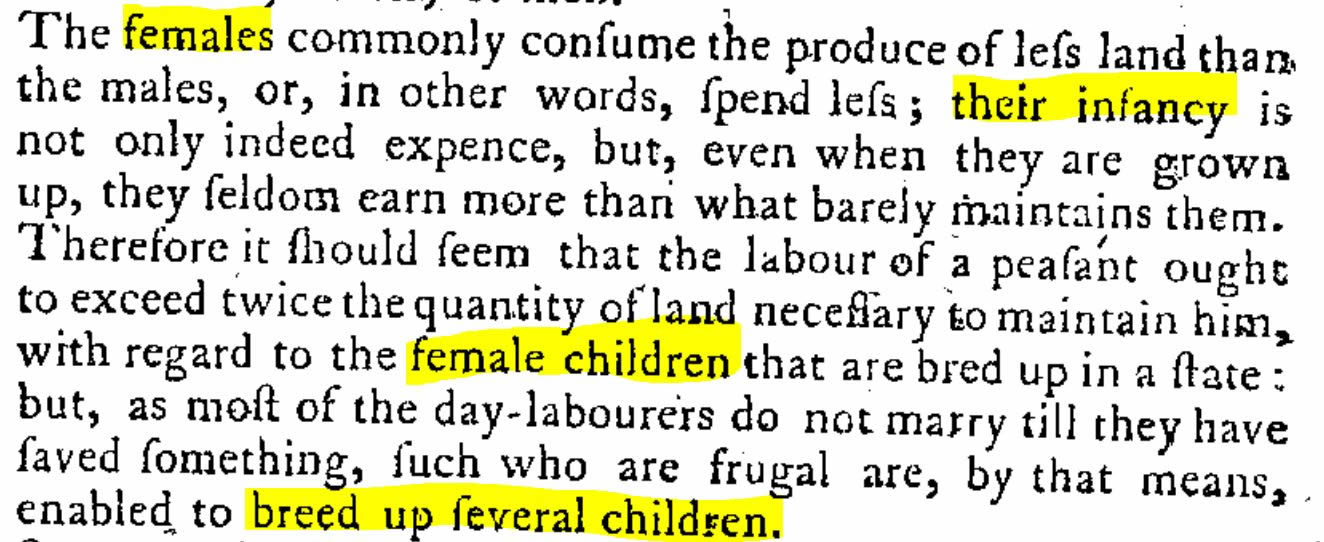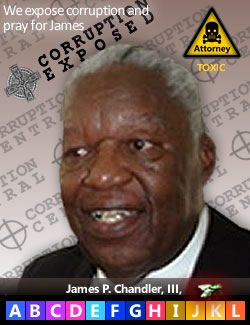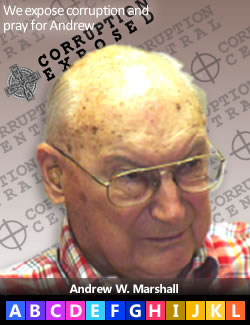Meet John Barker, Esq., the British Crown spy banker who handled Alexander Hamilton and whose banking progeny are ripping America apart today
"Hamilton made the First Bank of the United States a centerpiece of his financial plan. Modeled on the Bank of England . . ."* Geo. Washington's Mt. Vernon Online
* Monarch-controlled-protected; monopoly; unaccountable; private; opium, slavery, continuous war dependent; debt slavery-based; fiat currency; usurious; elitist interlocked; anti-competitive trading
Hamilton's first four banks were British shills and have become J.P. Morgan Chase, Wells Fargo, BNY Mellon, Citizens today

Barker was the banking puppet master who directed America’s ne’er-do-well “founder” Alexander Hamilton to eschew all banking and currency ideas (like land banks) except fiat currency and debt that aligned with the debt slavery plans of the British Empire, that included dominating America’s first banks. The Federal Reserve eventually emerged from his evil genius as an instrument of Mammon and Moloch.
Barker, as Governor of the Crown-chartered monopoly London Assurance Company, secretly provided the capital to provision both the Continental and French Armies, then the capital to create Bank of North America (1781), Bank of New York (1784) and First Bank of the United States (1791)—all with Alexander Hamilton's cooperation.
Contributing Writers' Note: We are still processing many bibliography references linked herein, so please return in a week or so to access the full set in PDFs.
Now we know, Hamilton betrayed America to British banks during the Revolution just like the communist left is doing today.
Queen Hillary Clinton is effusive in her praise of the Hamilton musical. So much praise, in fact, that Shakespeare might be tempted to re-write Queen Gertrude’s observation in Hamlet: ‘The lady doth praise too much, methinks.’ She said in her last campaign that "we may not live to see the glory" as the song from the musical Hamilton goes, "let us gladly join the fight." Let our legacy be about "planting seeds in a garden you never get to see."
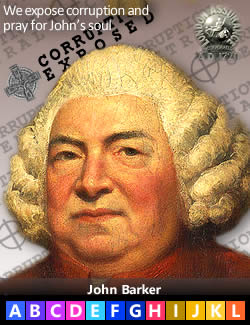
What kind of Hamilton-seeds are Hillary and her ilk planting?
Turns out, before the Rothschilds and Barings was John Barker, Governor of the Crown-chartered monopoly London Assurance Company, secretly bankrolled America’s first banks championed by his Crown Agent, Alexander Hamilton. (The Warburgs predate them all).
bookmark: #truth-history-about-alexander-hamilton | https://tinyurl.com/ye28vmec
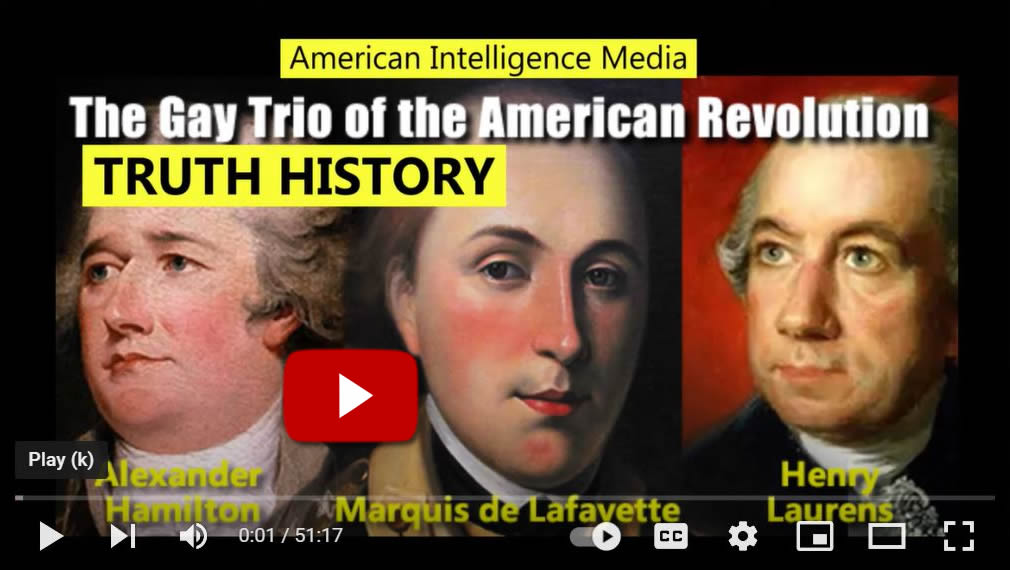
Apr. 21, 2022—Our investigations into Alexander Hamilton reveal that his seeds were sedition on behalf of the British Crown.
Hamilton secretly sold out America to British banks during the Revolution—while he was a staffer for General George Washington.
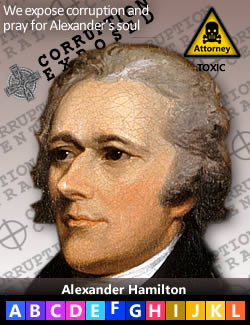
Remarkably, historians whitewash these facts and excuse his traitorous actions in the fog of war and social upheaval. Both are true, but Hamilton’s secret pre-Rothschild banking agenda with Britain profoundly betrayed our nascent country. Its effects plague us today.
Even historian Ron Chernow, whose history of Alexander Hamilton was used as the basis for the musical, equivocates on the historical accuracy of the Hamilton script.
Curiously, the musical opens with a conflated relationship among Alexander Hamilton, Marques de Lafayette and Henry Laurens that was inaccurate as chronology, but likely accurate as a gay-lover triad. Homoerotic indulgences were and still are a seminal hidden agenda among self-anointed British and American elitists.
How many gay guys conspiring does it take to cripple an emerging republic? Answer: Three.
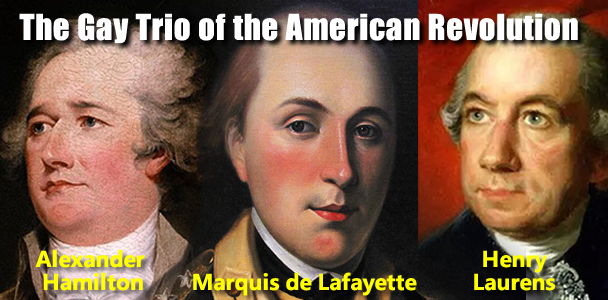
Fresh research is revealing Hamilton’s demon seeds—hidden by a flurry of British Crown historians who downplay or ignore the treachery-elephant in the room: Alexander Hamilton pressed bank fraud for Great Britain led by the demons Mammon (love of money) and Moloch (slavery, child sacrifice).
Even historian Ron Chernow, whose history of Alexander Hamilton was used as the basis for the musical, equivocates sheepishly on the historical accuracy of the Hamilton script, deferring to poetic license as justification for seminal inaccuracies, knowing full well that most of the audience will rely on it as truth history for their opinions of Hamilton the man.
Totally missing from the musical historicity is the fact that Hamilton injected himself, as an evident Crown Agent, into the formation and policy of America's first banks, fiat currency, usury and debt slavery:
- Bank of North America (1781)
- Bank of New York (1784)
- First Bank of the United States (1791)
- The Manhattan Company (1799)
Spy Alexander Hamilton orchestrated British control of American banking from the inception of the Republic
Hamilton’s work to dominate the formation of banks in the new American Republic was unmatched.
Hamiltonopolis
Hamilton advocated unrelentingly for the capital to be in New York. Chernow writes, "It was becoming so associated with Hamilton that his enemies branded it 'Hamiltonopolis.' For many southerners, Jefferson in particular, New York City was an Anglophile bastion dominated by bankers and merchants who would contaminate the republican experiment. These critics equated New York with the evils of London." (Chernow, p. 325) (html).
More than a few historians have questioned Hamilton's motives and impartiality. As Hamilton's four banks progressed, the complaints in New York circulated that “it became at length impossible for men engaged in trade to advocate republican sentiments without sustaining material injury . . . As the rage and violence of party increased, [bank] directors became more rigorous in enforcing their system of exclusion.”
"No type of corporation was more suspect than a bank . . . It was Republican dogma to be wary of an increase in business corporations which symbolized, as they had for a long time in England, monopoly power, speculative profit seeking, and moneyed influence." Ruebens, p. 580). (emphasis added).
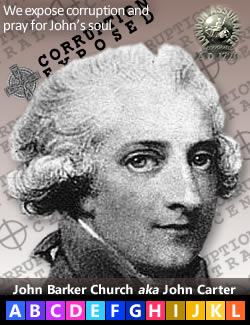
Hamilton involved his British banker brother-in-law, John Carter, aka John Barker Church, in all three banks as one of the largest founding shareholders and directors.
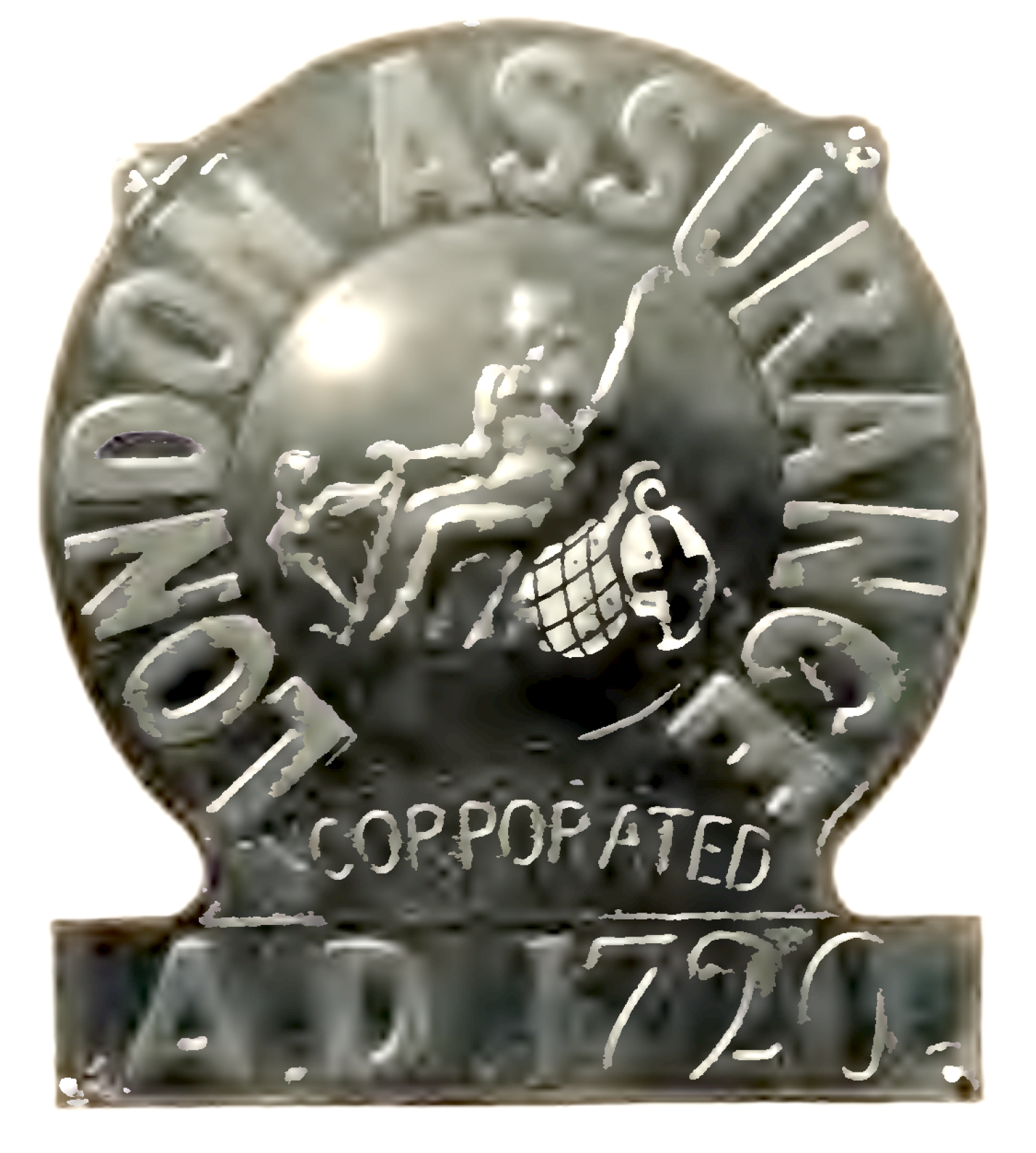
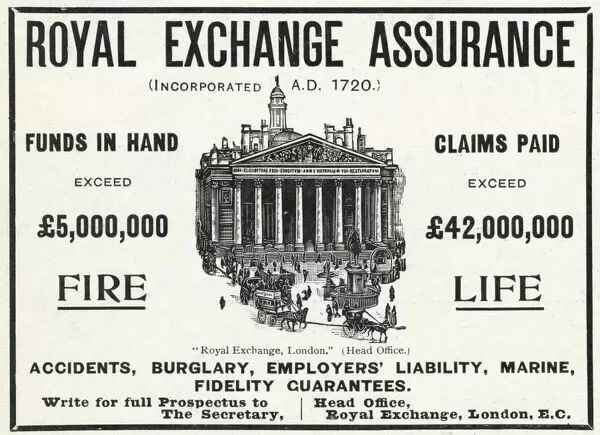
During the Revolution, the British Crown-chartered shipping, fire and life insurer, The London Assurance Company (chartered by the Bubble Act 1720 aka Royal Exchange and London Assurance Corporation Act 1719), had a worldwide monopoly. This insurance charter complemented The Bank of England charter of 1694 that was a sister Crown monopoly. The parallel Royal Exchange Company was led by Sir Francis Baring from 1780-80 (see First Bank of the United States below).
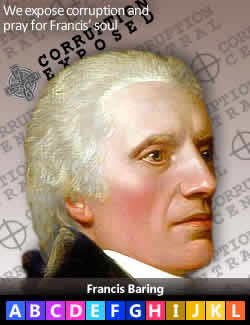
Sir Francis Baring is the father of Baron Alexander Baring.
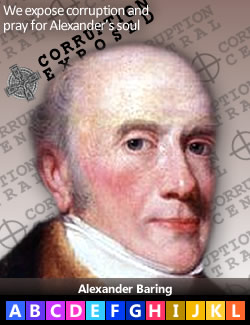
London Assurance was formed by the Royal Exchange and London Assurance Corporation Act of 1919 giving the Crown ironclad control of insurance underwriting throughout the empire, including America.
For 34 years, John Barker, Esq. ran London Assurance as director (1753), deputy governor (1771-77), sub-governor (1777) then governor (1777-87).
In other words, ships did not sail in British and American trade without his insurance. The private Lloyds of London came along later for specialty cases, but only London Assurance had the royal charter that liberally insured commerce, including slave and opium shipping.
John Barker had a namesake nephew named John Barker Church. Consistent with the blood-dynasty propensity among these bankers, Barker set up his nephew John Barker Church in business in England.
According to propaganda straight from UK Parliamentary archives, Church squandered his small fortune in gambling and stock speculation. Then, as the yarn is spun, Church changed his name to “John Carter” and moved to the American colonies in 1774, ostensibly to rehabilitate himself in anonymity. We now believe this was just the cover story. John Carter was evidently sent to protect the London Assurance Company Crown interests of his uncle in America.
Never mind that Parliament had just passed the Intolerable Acts in 1774 threatening martial law in Boston. The Continental Congress had responded with threats of a trade boycott that would dramatically effect London Assurance’s ability to continue insuring American ships and cargoes.
Truth is, Church changed his name to "John Carter" to disassociate him from his uncle so that he could be a secret London Assurance agent to manage the changing business winds.
From that point on, John Carter magically had all the funds he needed to bankroll inventories for the Continental and French armies, the to fund Alexander Hamilton’s first three nascent American banks—strapping America onto the demonic Crown Bank of England dead donkey from which were were striving to escape.
In fact, the archives show that many of America’s founding fathers knew about John Carter and his coming out as John Barker Church.
We conclude that the British Crown sent John Carter aka John Barker Church to America as their Crown Agent. He was tasked to ingratiate himself into one of the American families who were helping lead the Revolution. He did that by eloping with Angelica Schuyler in 1777.
Remarkably, within two years of his arrival in Boston, he was appointed a commissar of the Continental Army. Logically, he bought himself into this position—a stupendous achievement for a gambling stock manipulator, so the Parliamentary propaganda said.
Knowing that America would need a central bank, Carter-Church was tasked to use his funds liberally to make himself indispensable to the war effort, then offer to invest in the first banks, ostensibly for himself, but in fact for the British Crown in order to control the emergence of the new currency and bank debt.
Carter-Church surely saw Alexander Hamilton’s courtship and marriage to Elizabeth Schuyler—his wife Angelica's sister—on Dec. 14, 1780 as kismet. From that point on, Carter-Church was surely feeding the young Hamilton, then a staffer for General George Washington, with sophisticated banking ideas and goals well beyond his years (as numerous historians have observed).
Hamilton had no experience in banking and finance, yet (suspiciously) waxed eloquent, obnoxiously
The reader must remember, the 24-year-old Hamilton (b. Jan. 11, 1756; d. Jul. 12, 1804) had no experience in banking or insurance. He had been a teenage slave-trade clerk in St. Croix before moving to New York to study law at King’s College (Columbia Law), paid for by his slave-trade bosses. He obviously did not write his diatribes supporting central banks and debt-based currency.
What we shall show below is a timeline and proofs of this premise of Hamilton's conspiracy against the Republic.
| 1753-1787 | John Barker (b. 1707; d. 1787). For 34 years, John Barker, Esq. ran London Assurance as director (1753), deputy governor (1771-77), sub-governor (1777) then governor (1777-87. London Assurance Company had the Crown monopoly on shipping, fire and life insurance monopoly, including British and American opium, slave and tea trade shipping. | |||||||||||||
| 1771 | Jan 23 | Among his slave trafficking duties, a precocious Alexander Hamilton at 16 years old clerked for British-American slave trader Kortright & Cruger and organized the logistics (indexing, cataloging, promotion, oiling up) for an auction of 300 Africans from the Gold Coast. See Messrs. Kortright & Cruger (Alexander Hamilton, clerk). (Jan. 23, 1771). SLAVES (Three Hundred Prime) for auction, Vol. 1, No. 58. The Royal Danish American Gazette. | ||||||||||||
| 1773 | Alexander Hamilton entered King's College, New York (Columbia University) financed by his British-American slaver trader bosses Kortright & Cruger. | |||||||||||||
| 1773 | Dec 16 | The Boston Tea Party. | ||||||||||||
| 1774 | Mar 31 – Jun 22 | British Crown passed the Intolerable Acts to punish American colonists for the Boston Tea Party. | ||||||||||||
| 1774 | Aug | John Barker Church, the nephew of London Assurance governor John Barker, ostensibly went bankrupt from stock speculation and gambling (with the Prince of Wales!), changed his name to “John Carter,” and emigrated from London to Boston. See UK Parliament biography of John Barker Church. | ||||||||||||
| 1774 | Oct 20 | Continental Congress called for a boycott of trade with Britain by Dec. 01, 1774 if the Crown’s Intolerable Acts placing Boston ports under martial law were not rescinded. Note: The “Boston Brahmins” had been insuring their opium and slave ships with London Assurance since its founding by the Royal Exchange and London Assurance Corporation Act 1719 as a banker, insurer, shipper and supplier of opium to China for the Crown-controlled Levant Company (a merger of the Venice and Turkey Companies). |
||||||||||||
| 1775 | Apr 19 | The Battles of Lexington and Concord; “the shot heard round the world”—The begriming of the American Revolution. | ||||||||||||
| 1776 | Jul 04 | American Declaration of Independence. |
||||||||||||
| 1776 | Jul 26 | John Carter was appointed one of three commissioners by the Continental Congress to supply the army; another commissioner was Col. Jeremiah Wadsworth. “Church amassed fantastic wealth during the Revolution.” (html). | ||||||||||||
| 1776 | Oct 26 | John Laurens married Martha Manning, sister of William Manning, Governor of the Bank of England and Member of Parliament. Manning's father, of a St. Kitts planter family (sister island to Nevis where Alexander Hamilton was born), settled in London in the 1760s as a West India merchant. Manning himself was a partner in the family business successively with his father, his brother-in-law opium-slaver Benjamin Vaughan, and Anderdon and Bosanquet. Dir. Bank of England 1792-1810, 1814-31, dep. gov. 1810-12, gov. 1812-14; agent for St. Vincent 1792-1806, Grenada 1825-31; pres. London Life Assurance 1817 (John Barker, director, deputy governor, sub governor and governor for 24 years). | ||||||||||||
| 1777 | Mar 01 | Alexander Hamilton joined Gen. George Washington’s staff. | ||||||||||||
| 1777 | Jun 23 | John Carter eloped with and married Angelica Church (née Schuyler) daughter of General Philip Schuyler over her father’s strong objections. | ||||||||||||
| 1777 | Aug | "John Carter" resigned his commission and started a string of Boston businesses with business partner Col. Jeremiah Wadsworth in banking, shipping, land and currency speculation—businesses being blocked by the Continental Congress from his secret uncle John Barker, governor of London Assurance Company. | ||||||||||||
| 1780 | Dec 14 | Alexander Hamilton married Elizabeth Schuyler, Angelica Schuyler’s sister; therefore, Hamilton and John Carter became brothers-in-law. | ||||||||||||
| 1781 | Mar | Alexander Hamilton resigned General George Washington's staff as an aide-de-camp (staff assistant) in what propaganda describes as a clash of egos over Hamilton failing to attend a planned meeting. However, in hindsight, Hamilton was evidently planning the Bank of North America and was probably trolling for a reason to resign so he could get his British Agent handler John Barker Church ensconced as the bank's lead shareholder three months later. | ||||||||||||
| 1781 | May 26 | Today: Wells Fargo
Bank of North America chartered. Robert Morris was appointed by Congress to be the first superintendent of finance in 1781. Alexander Hamilton vied to be superintendent and was looked over, he was successful in arranging for his British brother-in-law, John Barker Church, to become one of the Bank of North America two largest shareholders (html). Then, while Church sailed to Europe to “settle wartime accounts” [and visit his London base of operations], Church named Hamilton his American business agent (html) in his absence and “deputized” him to watch over his Bank of North America interests and establish the Bank of New York (in 1791) (html). Interlocked British-American Banker Blood Notably, Robert R. Livingstone had proposed a"land bank" as the initial capital, Hamilton the banking neophyte was suspiciously vociferous in opposing the idea, deriding it as a "wild and impracticable scheme." (We believe his conduct is highly suspect since (a) Hamilton had no experience to make such brash statements, and thus, was evidently (b) pressing the agenda of his British Crown handlers, most notably John Barker, Governor of London Assurance.) |
||||||||||||
| 1781 | Oct 19 | Siege of Yorktown. | ||||||||||||
| 1784 | Mar 15 | Today: BNY Mellon
Bank of New York (html). founded and directed by Alexander Hamilton; chartered in 1791; started as a deputization of Hamilton by his brother-in-law John Barker Church to start the bank with Church's capital while he traveled to France and Britain to consolidate his fortune made from being the commissar for the Continental and French armies."Many Americans still regarded banking as a black, unfathomable art, and it was anathema to upstate populists. The Bank of New York was denounced by some as the cat's paw of British capitalists.) Chernow, p. 201. Hamilton's control of both the Bank of North America, Bank of New York, and the U.S. Treasury "decided that customs revenues could be paid not just in gold and silver but with notes from the Bank of New York and the Bank of North America, an innovation that began to steer the country away from use of coins and toward an efficient system of paper money." Chernow, p. 292. Note: Seems even the generally dispassionate Chernow could not resist slipping in the "efficient" adjective to nudge the unsuspecting reader toward our debt slavery bankers today. See Bank of New York. (Mar. 15, 1784). Constitution of the Bank of New York, [23 February–15 March 1784], Founders Online, National Archives. Original source: The Papers of Alexander Hamilton, vol. 3, 1782–1786, ed. Harold C. Syrett, pp. 514–518. New York: Columbia University Press, 1962. Clear Evidence of BNY History Censorship of British banking involvement in its formation in 1784: This 100-year history of The Bank of New York is generally accurate, but has essentially edited out (censored) the conspiracy between Alexander Hamilton and Briton John Barker Church, nephew of John Barker, Governor, London Assurance Company, in the formation of the bank, and does not identify J. B. Church's founding investment in bank founding stock. See p. 118. In fact, this history attempts to rewrite the founding history as if Hamilton and Church were not the brains behind the idea for the bank, so writes historian Broadus Mitchell (Alexander Hamilton, p. 99): "His principal part in promoting the Bank of New York and his pursuit of a charter for it..." History of the Bank of New York, p. 9 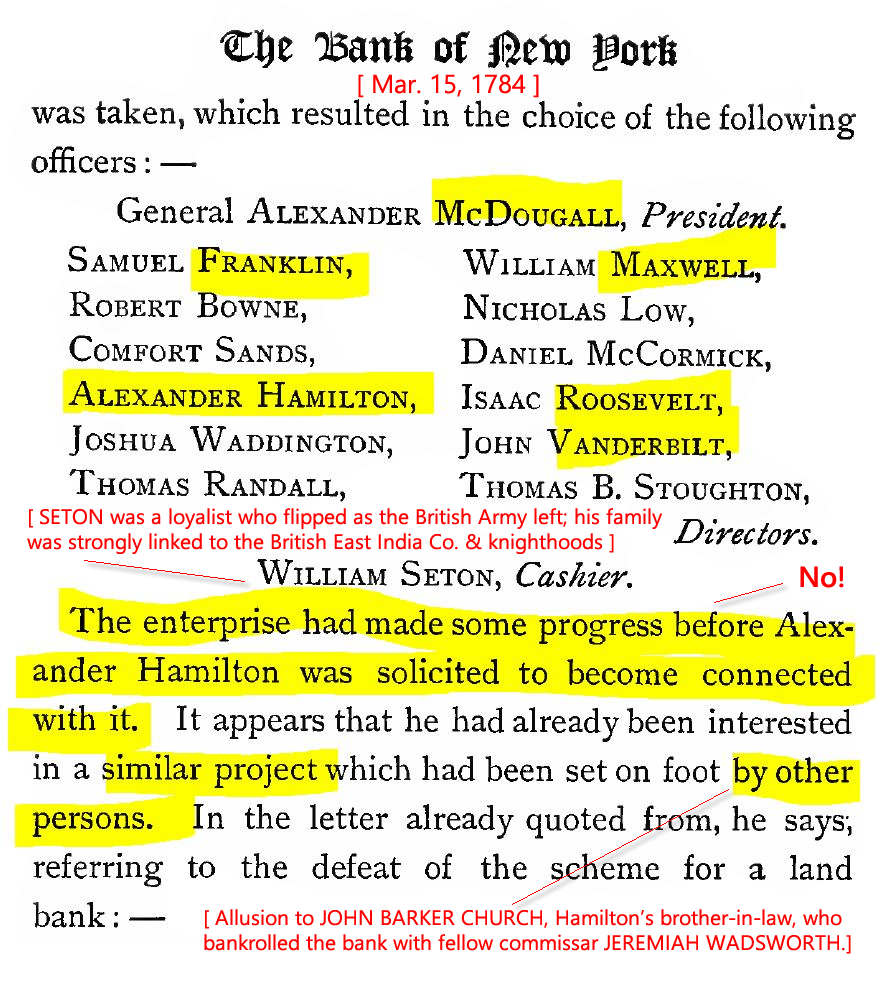 See Henry W. Domett. (May 01, 1884). A History of the Bank of New York 1784-1884, Fourth Edition, p. 9. G. P. Putnam's Sons, NY, London. |
||||||||||||
| 1784 | May 12 | Treaty of Paris ended American Revolution. Bookmark: #first-bank-of-us | https://tinyurl.com/348jxnm2 |
||||||||||||
| 1791 | Feb 25 | Today: BNY Mellon, Citizens, HSBC
First Bank of the United States. "Hamilton made the First Bank of the United States a centerpiece of his financial plan. Modeled on the Bank of England . . ." —Kieran J. O'Keefe, George Washington's Mount Vernon Online. The First Bank of the United States was founded by Alexander Hamilton; early stockholders included John Barker Church. By 1810, the Britons Alexander Baring and Rothschild & Sons Ltd. banks had acquired major stakes in the First Bank of the United States as well as in the Bank of England. See Baron Alexander Baring's massive legacy in the global slave trade. See also Alexander Baring. (1805). Bank of England Directors Ledger, pp. PDF 13-35. UK Parliament. 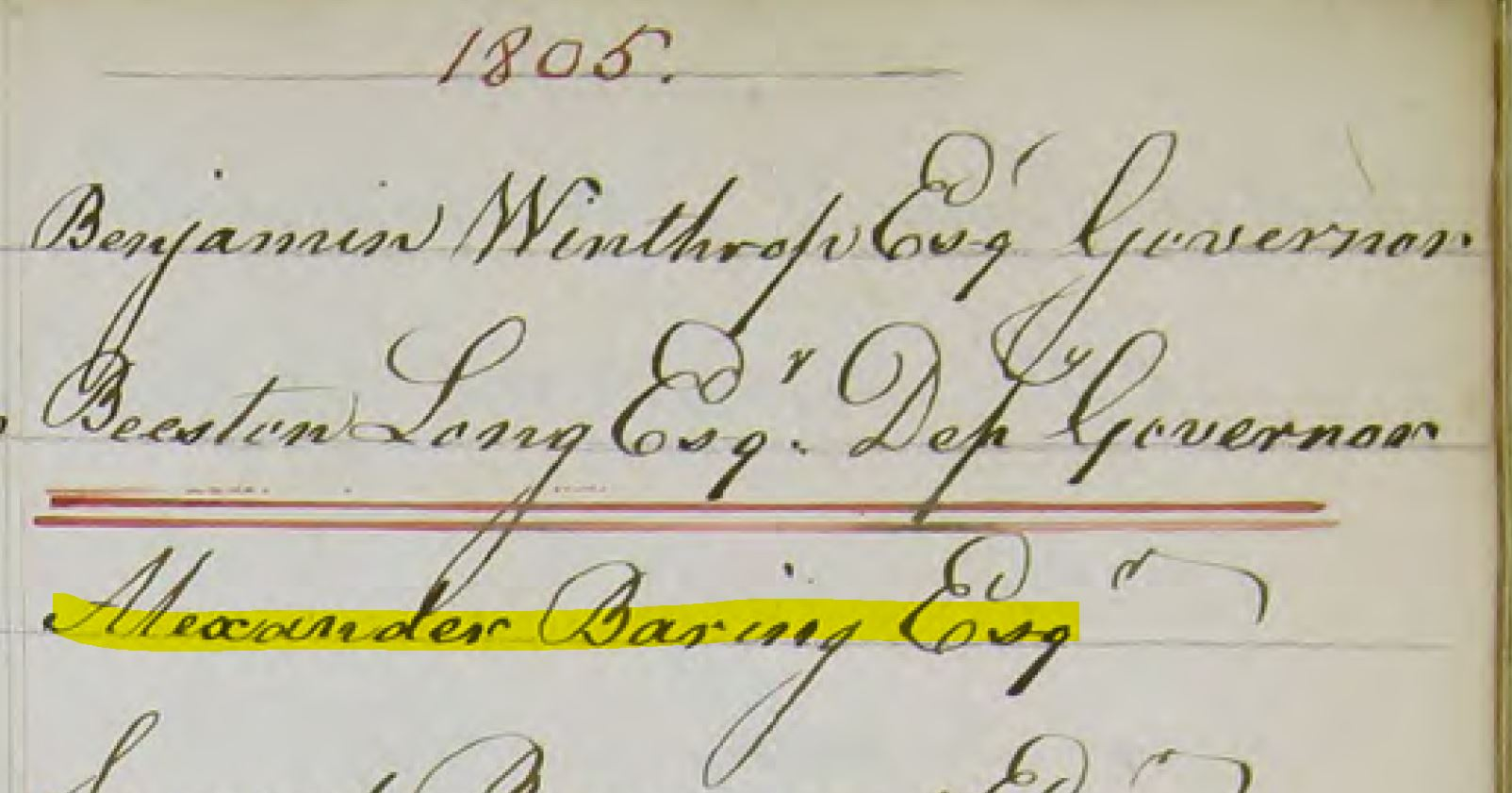 Another of the first stockholders in Hamilton’s First Bank of the United States includes Thomas M. Willing, who was the richest man in America. Willing studied in Bath, England and studied law at the London Inner Temple. From 1781 to 1791, Willing served as president of the Bank of North America, preceding John Nixon. In 1791, President George Washington appointed Willing along with two others as commissioners of the newly created First Bank of the United States. He was elected president of the bank later that year, and during his tenure, he became the richest man in America. More Interlocked British and American Bank Blood Thomas M. Willing had 13 children. His granddaughter Ann Louisa Baring née Bingham married Alexander Baring who was a director and governor of the Bank of England from 1805-1815 (during the War of 1812 burning down of the White House). Baring sat in parliament for Taunton between 1806 and 1826. See example of the close cooperation of the Rothschilds and Barings in 1865 at the time of the assassination of President Abraham Lincoln. See also: Editor. (Apr. 18, 2022). Alexander Hamilton Takes Control Over Early Banks in America. American Intelligence Media; John Thom Holdsworth. (1873). U.S. Government 1802 $1,287,600 stock sale of holdings in the First Bank of the United States to Sir Francis Baring (UK, 1740-1810), 146 pgs., pp. 49, 89. First Bank of the United States, U.S. Senate Document. After the 20-year charter expired, the bank, buildings and furnishings were purchased by Stephen Girard to create Girard Bank. Girard was an opium and slave trafficker allied with the British Baring Brothers and various Boston Brahmins, notably Perkins, Forbes, Russells and Astors. See Ernst Graf. (Dec. 29, 2014). The British Brahmins in the U.S. Serpent's Egg. Exposes the interlocking British-American families who were built on the opium and slave trade in Boston, Philadelphia and New York, including Alexander Hamilton, Aaron Burr, Jeremy Bentham, John Jacob Astor, British East India Company, The Levant Company, Baring Brothers, Hong Kong and Shanghai Bank (HSBC), William Bingham, Stephen Girard, Girard Bank and Trust (First Bank of the United States), Jardine, Matheson, Sassoon, Japhet, Dent. the Perkins and Forbes families, William Hathaway Forbes, Russell and Company, John Murray Forbes, Morgan Bank, First National Bank of Boston, Harvard University, Willard Straight, Morgan et Cie, Chatham House (Royal Institute of International Affairs, Institute of Pacific Relations, People's Republic of China, and Waldorf Astor... this activity all now overseen by the British Pilgrims Society. "The operation of the first Bank of the United States through branches constituted a rather remarkable foreshadowing of the regionalism embolied in the present Federal Reserve System." (New Light on the First Bank of the United States, UPenn, PDF p. 16.) Proof of British and European debt-based influence over early American banking 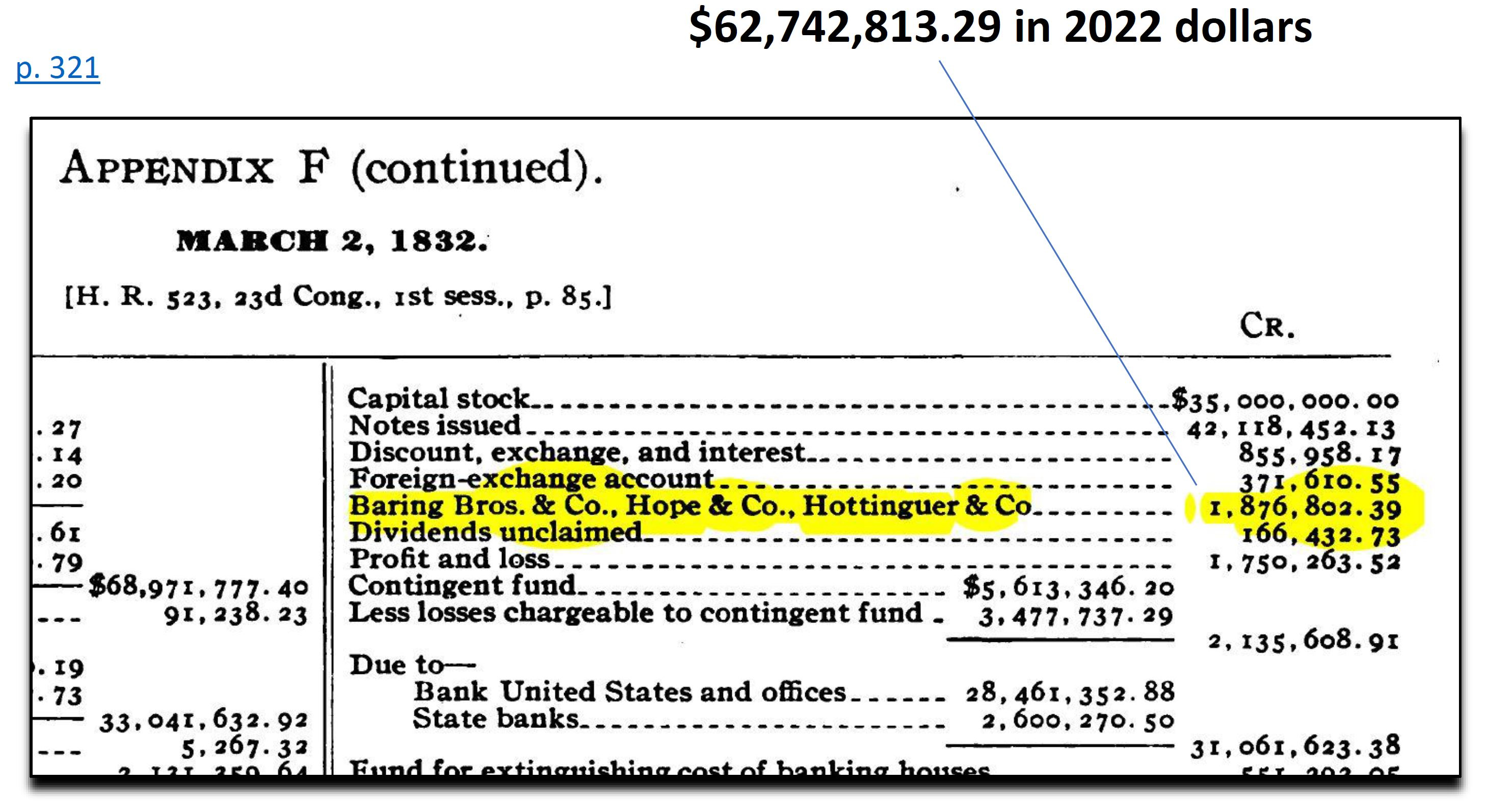 John Thom Holdsworth, Ph.D., Davis R. Dewey, Ph.D. (1909). Baring Bros. & Co., Hope & Co. and Hottinguer & Co (Cie] stock in the First Bank of the United States, National Monetary Commission, The First and Second Banks of the United States, incl. Balance Sheets, SENATE DOCUMENTS, 1909-1910, 61st Congress, 2nd Session, Vol. 26, Serial Set 5625 (1909/10), Doc. No. 571, pp. 89, 308, 310, 311. GPO.
See also Sir Francis Baring, 1st Baronet. (Accessed Apr. 03, 2022). Biography. PipiWiki. |
||||||||||||
| 1799 | Apr 02 | Today: J.P. Morgan Chase
The Manhattan Company, promoted by Alexander Hamilton and Aaron Burr; invested in by John Barker Church who became a director at Hamilton's behest. See also Chernow. (html, also search "Manhattan Company" for pp. 621, 623-26, 639, 641).A good example of the censorship of history is a history of The Manhattan Company written by Brian Phillips Murphy. Murphy mentioned John Barker Church just once in Footnote 31 in a list of Federalist directors. This is despite the fact that the founders of the Manhattan bank, Aaron Burr and John B. Church, fought a duel on the very day of the founding! Murphy had no analysis of John B. Church as a looming figure over the bank, no context since Church was also one of the largest shareholders in the Bank of North America and likely of the First Bank of the United States. Current J.P. Morgan CEO Jamie Dimon was no doubt appreciative of Murphy's knowingly negligent history (otherwise called a sin of omission, or a lie). 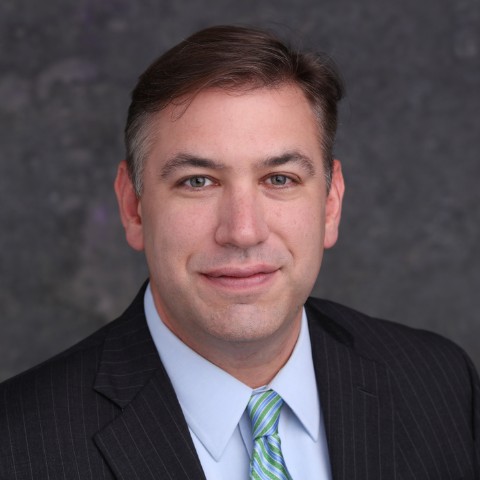
Fig. 9—Brian Phillips Murphy. Associate Professor of History, Rutgers University. Murphy even interviewed Lin-Manuel Miranda, the Hamilton playwright, where he threw him softballs, and let him arm-flail, over talk him and let him off the hook about ignoring slavery (not to mention ignoring banking!)... in favor of "it's entertainment!" Miranda admitted he is cooperating with the globalist, pro-British Crown Rockefeller Foundation. The sad fact is, for most of Hamilton's audience, this musical will define their notions of Hamilton and America's founding, truths, half-truths, omissions, lies be damned. For this reason, Murphy's interview was little more than narcissistic hero worship and a disservice to exposing the British Crown poison that entered our American Republic through Hamilton's treachery. |
||||||||||||
| Table 1: Timeline of Alexander Hamilton's treachery handled by the British Crown Agents. | ||||||||||||||
American banking was never on its own from inception, largely thanks to Alexander Hamilton’s treachery and treason.
Tellingly, the Hamilton musical completely skipped history of the most sinister banking treachery by Hamilton against the new American republic between Acts I and II
Act I does not show that Hamilton was born a British subject (html), in the reign of King George II. Chernow even calls him “America’s foremost Anglophile.” Somehow the Hamilton producer missed that critical fact.
Act I does not show that Hamilton’s Caribbean Island home colony of St. Croix thrived on the African slave trade where there were four black slaves for every white on the island. IT also ignores that Hamilton’s gay friend Henry Laurens was one of the largest slave traffickers in America.
Act I does not show that Hamilton’s formative years on Nevis and St. Croix were steeped in the empire-sanctioned rape, sodomy (buggery), whippings, amputations and black-white carnal relations of a “feudal order” (html) supported by His Majesty’s Royal Council for the Province.
Act I does not show, most notably, that Hamilton’s first job (ca. 1766-68) was as a clerk in the New York-St. Croix slave trafficking firm of Kortright and Cruger (renamed from Beekman and Cruger) on Christiansted, St. Croix.
Act I does not show that Hamilton’s mother Rachel had moved Alexander and his brother James, Jr. to St. Croix after her divorce from James Hamilton. She remarried to a Jewish Dane ogre named Johann Michael Lavien, a dozen years her senior. Lavien, after failing to horn in on a small Scottish inheritance that Rachel was awarded but never received, accused Alexander and James, Jr. of being whore-children in order to justify an annulment.
Act I does not show that Alexander, as a precocious 14-16 years old clerk (starting ca. 1766-68), helped Kortright and Cruger manage their slave trafficking business, including cataloging, pricing, promoting and auctioning at least 550 Africans from the Gold Coast, as well as advertising for the capture of their runaway slaves properties.
Click image to view the PDF.
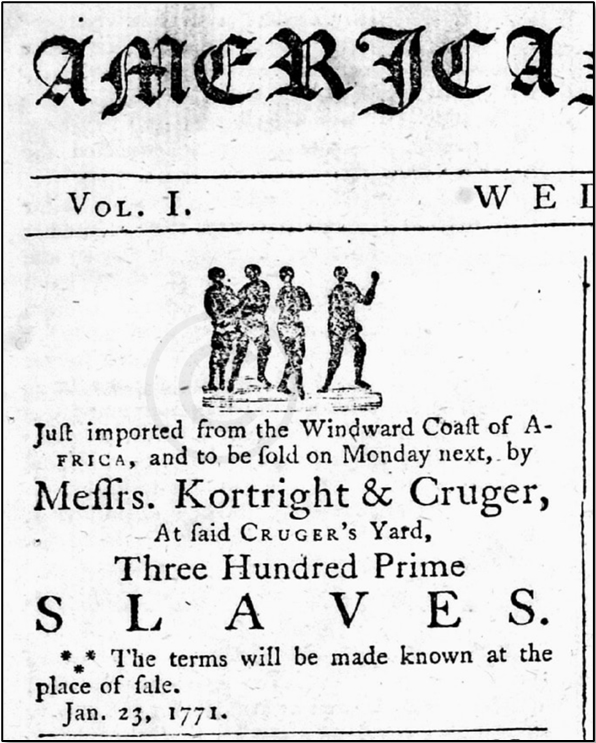
See actual Kortright & Cruger “Three Hundred Prime SLAVES” auction advertisement from Jan. 23, 1771 in the Royal Danish American Gazette.
The Gazette was edited by Hamilton’s friend and mentor Hugh Knox (html), who was the likely sponsor of Hamilton’s college “subscription fund” that included his slaving trafficking bosses Kortright and Cruger who had a dock in Manhattan named Cruger’s Wharf (constructed in 1739, destroyed by a great fire in 1778, filled in to become Front Street today).
Chernow writes: “From the frequency with which Nicholas Cruger placed newspaper notices to catch runaway slaves, it seems clear that the traffic in human beings formed as substantial portion of his business.” (Chernow, p. 32) (html).
Cruger’s Wharf in Manhattan is where the newly-arrived Alexander Hamilton went to pick up his college “subscription fund” money–slavery blood money–to enter King’s College, New York (founded in 1754 by King George II royal charter just 20-years earlier).
King’s College was renamed Columbia University in 1784—the same year that Alexander Hamilton founded The Bank of New York.
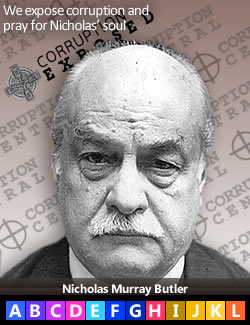
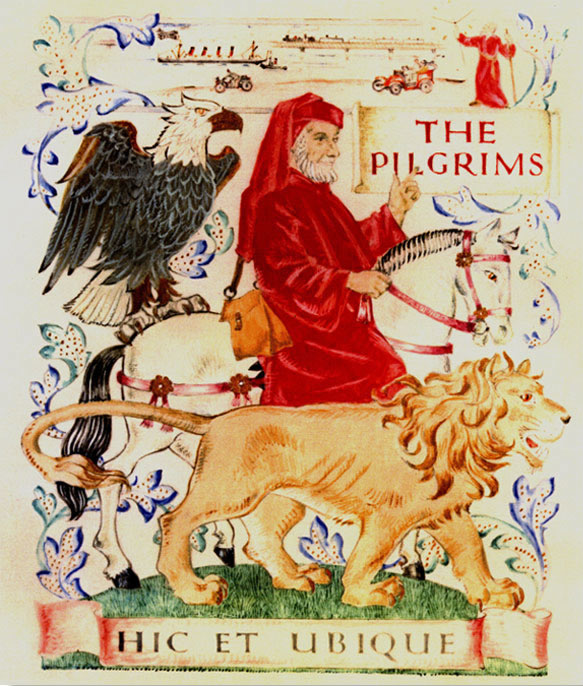
For context, Anglophile Nicholas Murray Butler was the 12th president of Columbia from 1902-45—43 years. Butler was a co-founder of the British Pilgrims Society in 1902, and served as president of their American “branch” from 1928-46. See The Pilgrims of the United States (2003: Profile Books). Butler oversaw the grooming of Franklin D. Roosevelt, Sir Walter Rothschild, William J. Donovan, and J.P. Morgan (The Manhattan Company), among others. Barack Obama was also groomed at Columbia.
Now to the Act I elephant in the room that the Hamilton musical ignored
Alexander Hamilton at age 26, while still employed as General Washington’s aide-de-camp and pining for a battle command, began pushing himself forward to be the superintendent of finance in the Continental Congress, but was skipped over in favor of Robert Morris.
Bookmark: #hamilton-slaver-mentor | https://tinyurl.com/ycx9w52eNot dissuaded, Hamilton read two pro-British Empire financing books and one tract* then wrote a 31-printed-pages treatise to Morris on how to shore up America’s credit and establish a national bank, even though he opened with “I pretend not to be an able financier. Neither have I had leisure or materials to make accurate calculations.” (Chernow, p. 156).
* David Hume, Esq. (Apr. 18, 1776). Political Discourses, 321 pgs. R. Fleming.
Hamilton's financial mentor Briton Hume promoted two classes of humanity:
Click image to enlarge p. 7.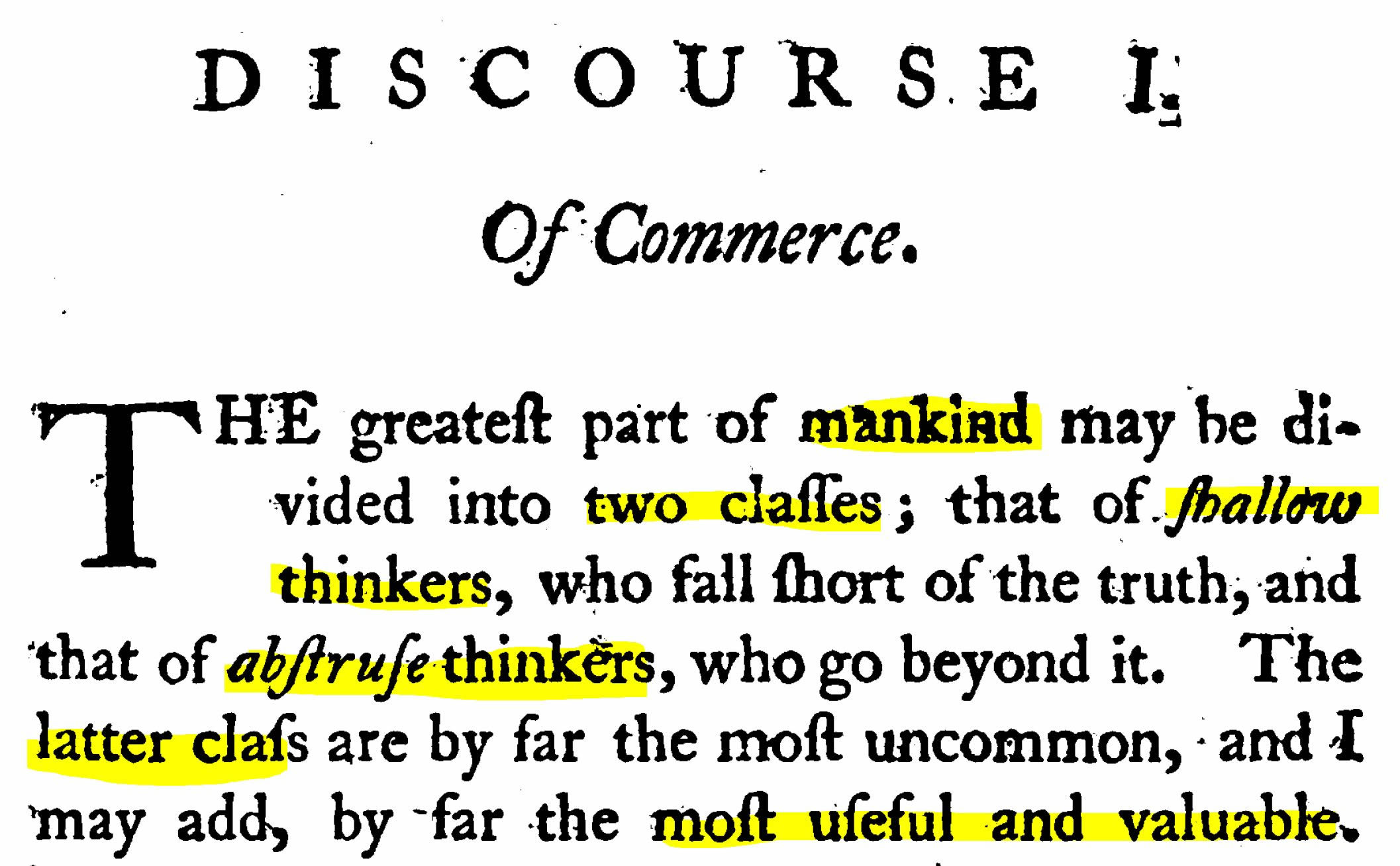 Fig. 15—David Hume, Esq. (Apr. 18, 1776). Political Discourses, 321 pgs. R. Fleming. See David Hume biography.
Fig. 15—David Hume, Esq. (Apr. 18, 1776). Political Discourses, 321 pgs. R. Fleming. See David Hume biography.
"DISCOURSES I. Of Commerce.
The greatest part of mankind may be divided into two classes; that of shallow thinkers, who fall short of the truth, and that of abstruse thinkers, who go beyond it. The latter class are by far the most common, and I may add, by far the most useful and valuable."Malachy Postlethwayt, Esq. (Feb. 10, 1766). The Universal Dictionary of Trade and Commerce, Vol. 1, 1085 pgs. H. Woodfall et al. (134 MB).
Malachy Postlethwayt, Esq. (Feb. 10, 1766). The Universal Dictionary of Trade and Commerce, Vol. 2, 942 pgs. Third Edition. H. Woodfall et al. (125 MB).
Hamilton's slaver mentor on female and child labor:
Malachy Postlethwayt was a governor of the Royal African Company, London (1660)—the chief promoter of the African slave trade. It shipped more African slaves to the Americas than any other company in the history of the Atlantic slave trade.
See Derek Wilson. (Dec. 07, 2017). Royal African Company: How the Stuarts Birthed Britain’s Slave Trade. History Answers UK.
Click image to enlarge p. 7.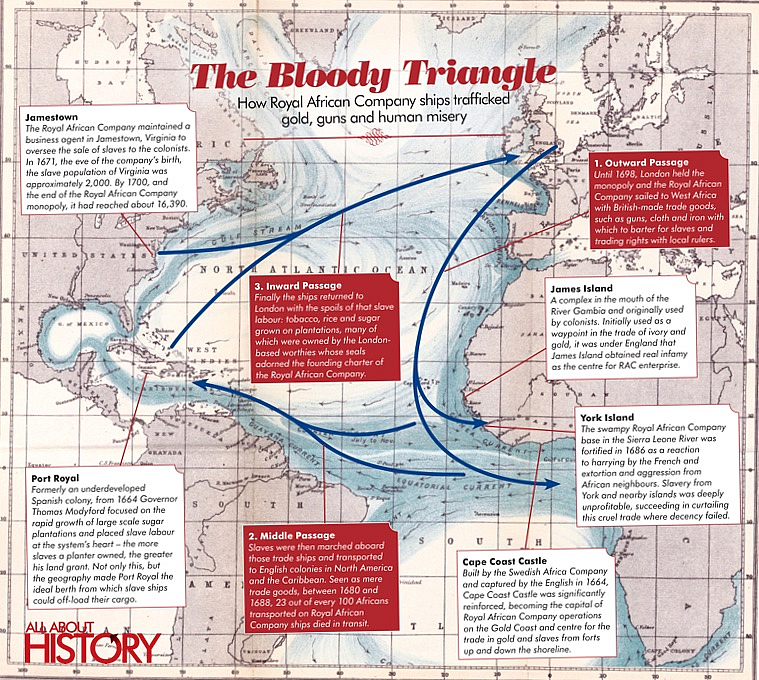 Fig. 16—Royal African Company (1660) -- The Bloody Triangle. Derek Wilson. (Dec. 07, 2017). Royal African Company: How the Stuarts Birthed Britain’s Slave Trade. History Answers UK.
Fig. 16—Royal African Company (1660) -- The Bloody Triangle. Derek Wilson. (Dec. 07, 2017). Royal African Company: How the Stuarts Birthed Britain’s Slave Trade. History Answers UK.
"1. Outward Passage: Until 1698, London held the monopoly and the Royal African Company sailed to West Africa with British-made trade goods, such as guns, cloth and iron with which to barter for slaves and trading rights with local rulers."Richard Price. (Mar. 12, 1776). Nature of Civil Liberty, the Principles of Government, and the Justice and Policy of the War with America, Ninth Edition, 49 pgs. Dilly and Cadell.
Hamilton argued that establishing public credit was more important than winning battles. His proposal mimicked the British financial system of debt, usury and fiat currency discussed in the above documents.
What secret British Crown banker strategy did he know that he did not tell General Washington and Congress? Why was he so impetuous about starting banks where he would direct policy toward the British debt system?
Robert Morris was appointed by Congress to be the first superintendent of finance in 1781—two years before the Treaty of Paris between America and Britain in 1783.
While Hamilton did not get appointed superintendent, but he was successful in arranging for his British brother-in-law, John Barker Church, to become one of the Bank of North America two largest shareholders.
Then, while Church sailed to Europe to “settle wartime accounts” [and certainly to visit his London home], Church named Hamilton his American business agent in his absence and “deputized” him to establish the Bank of New York in 1784 (read: leveraging London Assurance capital).
Who was Englishman John Barker Church

He was Alexander Hamilton’s brother-in-law, married to Angelica Schuyler Church, the sister of Hamilton’s wife Elizabeth (“Eliza”) Hamilton (born Schuyler).
After the American Revolution, Church returned to England and became a Member of Parliament for Wendover (UK) (1790-96) (between London and Oxford).
The following information about John Barker Church is publish on the British Parliamentary website.
In very odd phraseology, Parliament repeats “a defamatory account” that Church went bankrupt in Aug. 1774 from stock speculation and gambling. Were the Parliament's librarians admitting this was a lie, and they knew it?
Remarkably, after the Revolution, in 1788, John Barker Church moved back to London as one of the wealthiest men in America. He bought property near Windsor and became a Member of Parliament for Wendover from 1790-96. He gambled with the Prince of Wales regularly. That is not something done except with political insiders.
In 1799, Church returned to America where he became a founding member of the Manhattan Company (Bank) (now J.P. Morgan Chase) and director of the Bank of North America (now Wells Fargo). In 1800 he was admitted as an honorary member of the New York Society of the Cincinnati.
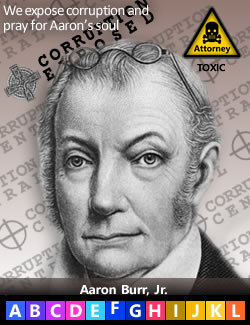
Also in 1799, Church dueled Aaron Burr—one of the founders of the Manhattan Company (Bank) where he was a director and large shareholder. No one was hit, so they reconciled. Later, some say Church’s pistols were used in the duel between Burr and Hamilton on July 11, 1804 where Hamilton died. Burr says they were his pistols.
Given the demonic banking legacy these men heaped upon our young republic, it is hard to feel sorry for Hamilton’s fate. Literally hundreds of millions of souls have died for their greed and ambition.
Click image to view the PDF.
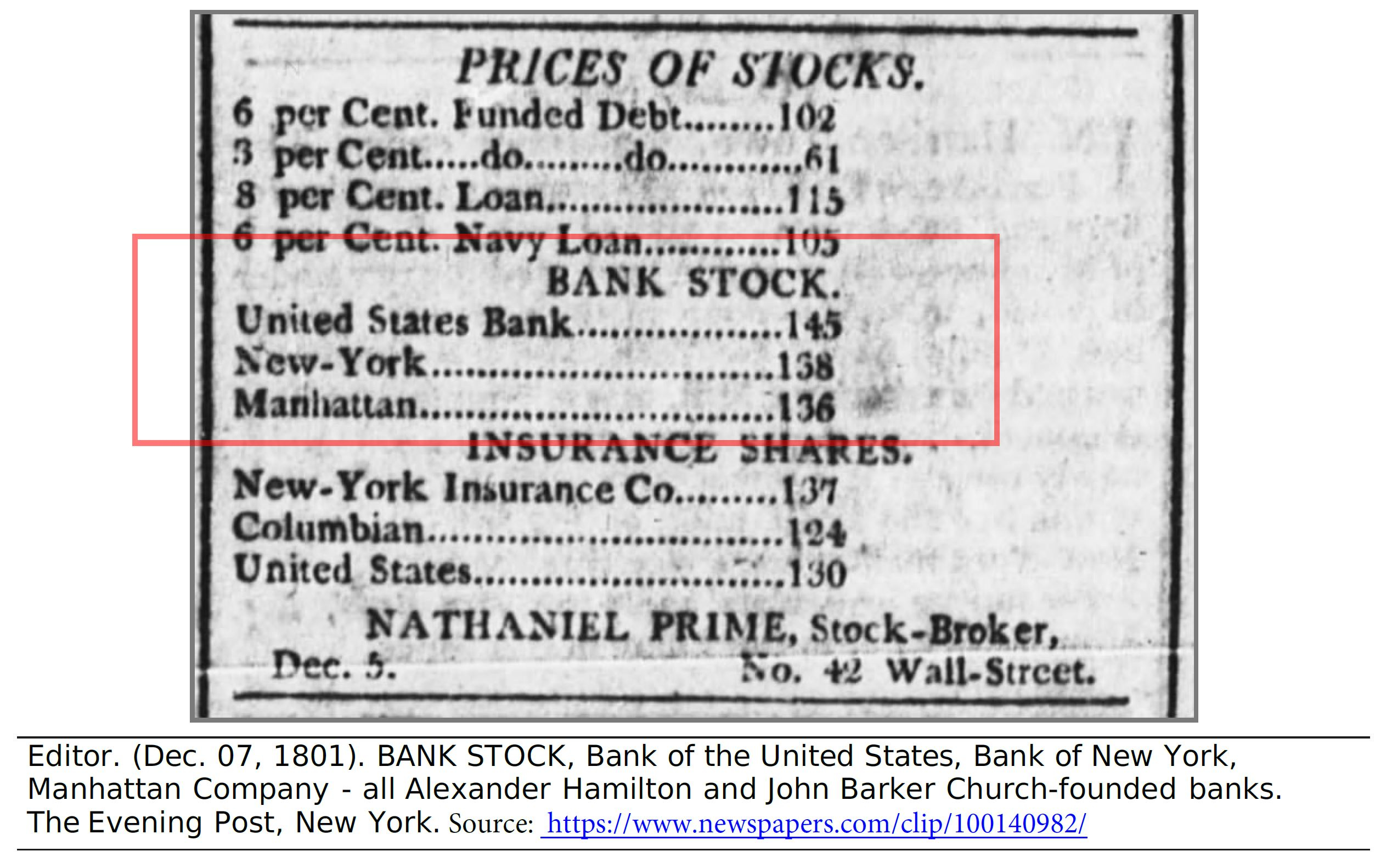
Conclusion
The evidence is overwhelming that Alexander Hamilton was not just a young man caught up in the confusion of war and social strife, but was a British Crown Agent with a mission to assure the British Crown that America’s new banking system and currency would be based on debt and usury.
When Robert R. Livingston (html) proposed a land bank system, the young Hamilton derided it as a “wild and impracticable scheme.” His emotional response certainly telegraphed a hidden agenda from across the ocean to protect.
Where did he get such seasoned opinions? Certainly not from his experience. Evidently, he received his instructions from The London Assurance governor John Barker, Barker’s nephew John Barker Church, and the Bank of England.
Consequently, Alexander Hamilton and his Crown Agent accomplices assured the new American Republic would begin its banking a and currency life with one hand tied behind its back by its mortal British nemesis.
Indeed, the British Crown was successful in institutionalizing the demons of Mammon and Moloch in our blessed Republic.
We must close their offshore bank accounts, and shut down the Federal Reserve and their grifters at the IRS.
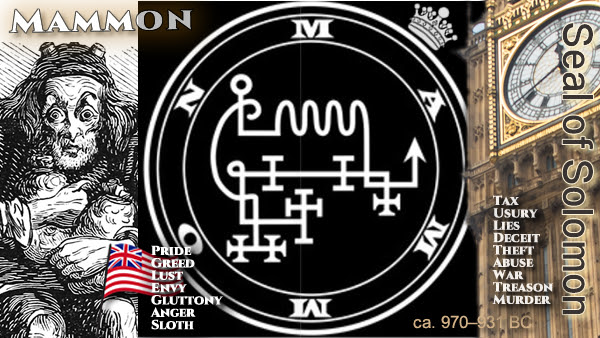
* * *
Footnote:
Click image to view the PDF.
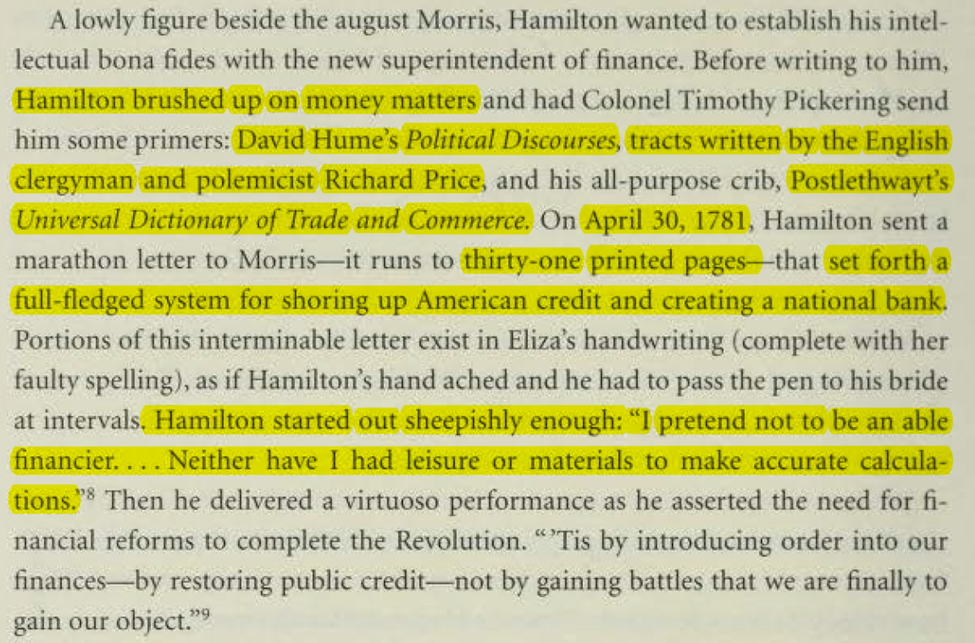
Click image to view the PDF.
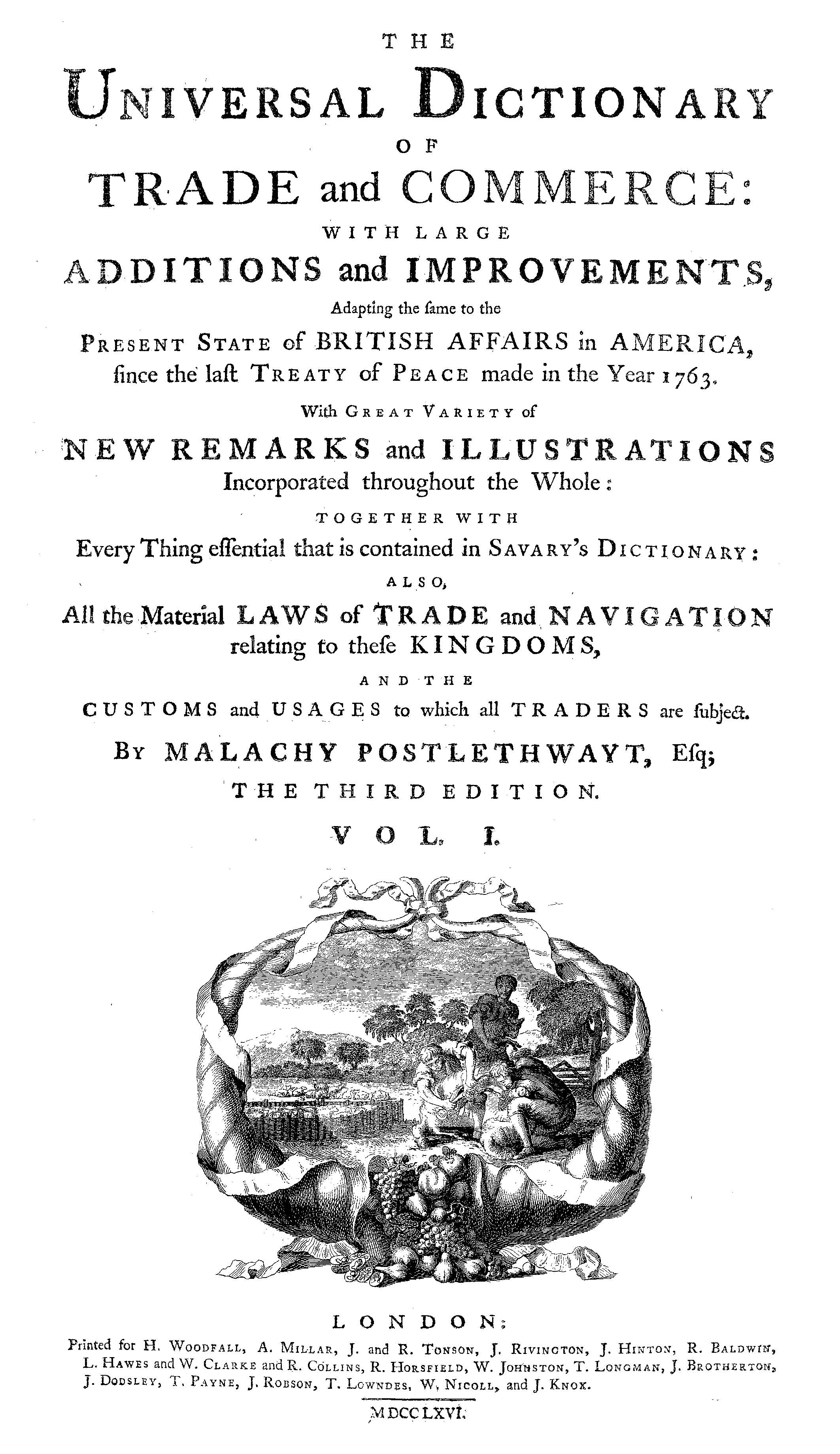
Click image to view the PDF.
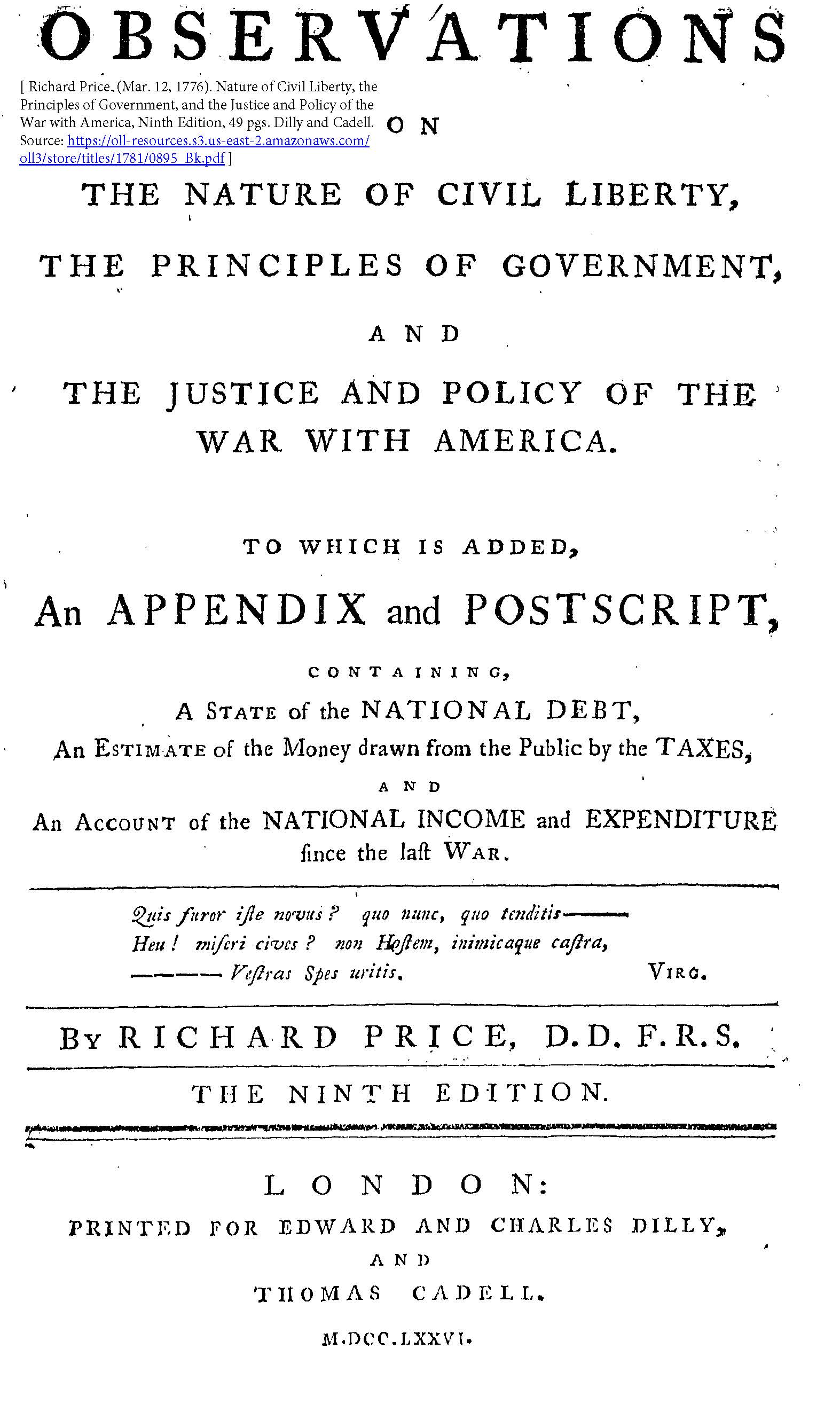
Click image to view the PDF.

Described above is abject immorality.
Morality must win the day.
"Repent, for the kingdom of heaven is at hand."
The Gospel of St. Matthew 4:17.
Bookmark: #miller-act-notice | https://tinyurl.com/42kf48fn
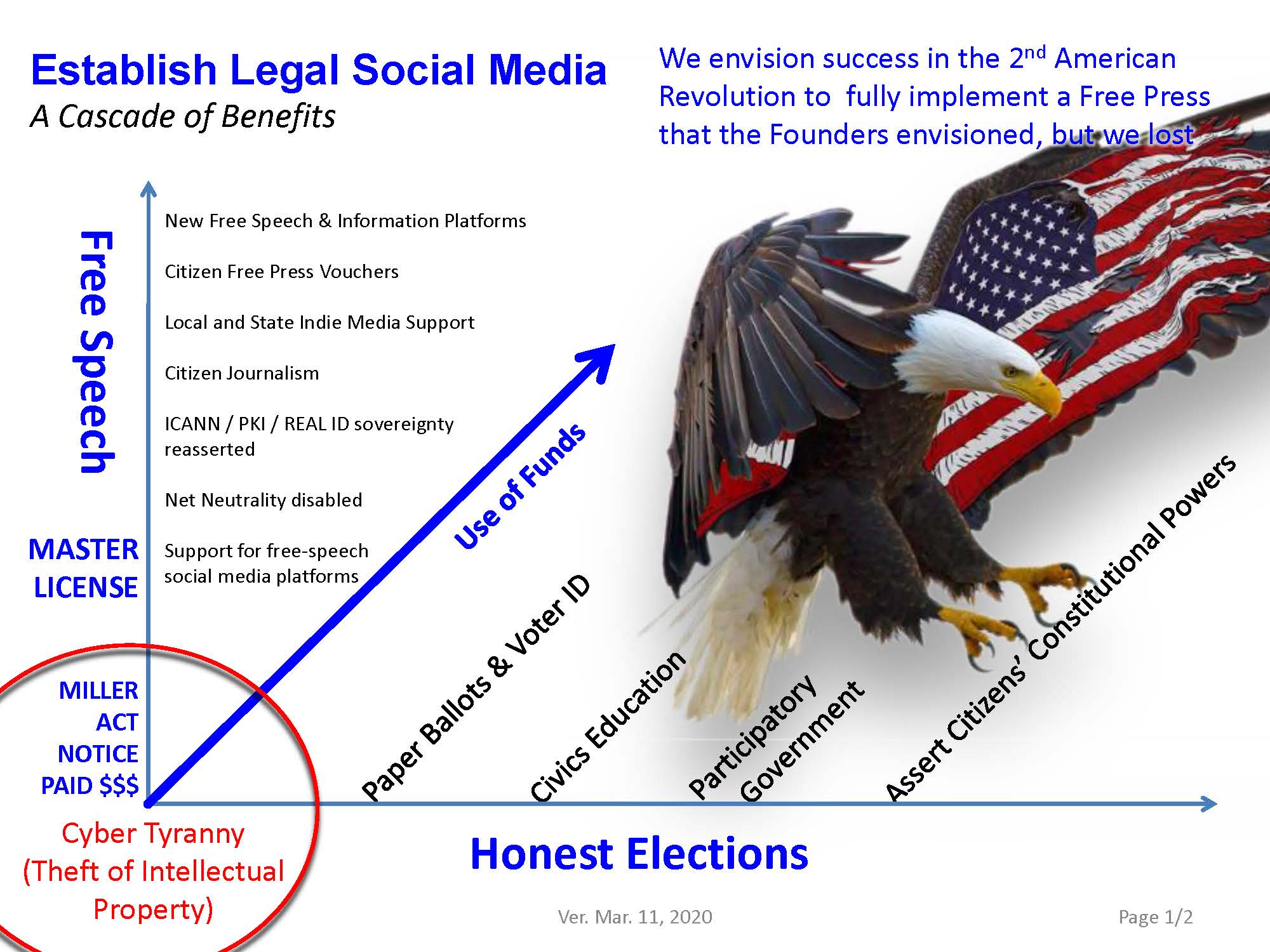
Leader Technologies, Inc. sent their FIRST AMENDED MILLER ACT NOTICE to President Trump (the then-current President) It is a contract demand for the U.S. Treasury to pay them for the federal government's 18-year theft of their social networking inventions. These inventions were stolen by Major General James E. Freeze (US Army, ret.) and Leader's patent attorney James P. Chandler, III, on behalf of Andrew W. Marshall and the Department of Defense Office of Net Assessment, and the Pilgrims Society who steal and weaponize inventions for continuous war making and enrichment of fascist insider military-industrial corporations.
Patriots are encouraged to help get this First Amended Miller Act Notice to President Trump and past the Praetorian Guard. See American Intelligence Media republish of the Leader Miller Act Notice.
Return to return to the beginning of this post.
Notices: This post may contain opinion. As with all opinion, it should not be relied upon without independent verification. Think for yourself. Photos used are for educational purposes only and were obtained from public sources. No claims whatsoever are made to any photo.
Comment
Click "N comments:" on the line just below this instruction to comment on this post. Alternatively, send an email with your comment to afi@leader.com and we'll post it for you. We welcome and encourage anonymous comments, especially from whisteblowers.

 e.g. "IBM Eclipse Foundation" or "racketeering"
e.g. "IBM Eclipse Foundation" or "racketeering"
